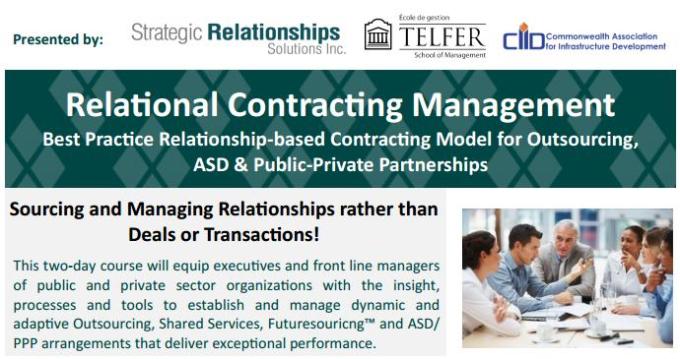Now that we have in my previous post, identified what a high performance relationship actually is, the next question is how do you find one? Or perhaps the better word would be “establish” one?
“The contract must become a platform to manage inevitable change, not pursue certainty based on the original deal.” – Ian Mack. Director General Major Project Delivery (Land & Sea), Canadian Department of National Defence
The “Relational” Ties That Bind
Establishing a collaborative high performing relationship requires a different sourcing process, as one cannot use the prescriptive or familiar procurement mechanisms to source a dynamic business relationship.
This becomes particularly important as it relates to Futuresourcing projects.
With Futuresourcing projects, where neither the client nor the vendor has constructed, built or delivered the required capability, past work experience cannot be solely relied upon or used as a selection criteria.
In sourcing dynamic relationships, a closer examination of the vendor’s strategy and core capabilities are paramount to determining the likelihood of the ultimate success of the relationship.
In this context, all projects should be viewed with this fresh look of uncertainty, especially given the fact that the vast majority have failed to deliver the expected results.
Beyond these needed checks and balances, the sourcing process about which I will be talking today, advocates an intense industry analysis and engagement before and during the actual procurement, as well as post procurement. This sourcing process also involves the application of advanced analytical tools to objectively assess and evaluate the fit between a vendor’s strategy, core capabilities and the initiative’s strategic objectives in relation to the expected outcome.
With high performing relationships, collaboration is born out of common purpose and intent, and must therefore be a product of strategic fit. The advanced analytical tools associated with my SRS relational model are used to determine the veracity of the “strategic fit” between the client and vendor. This “fit” as I call it is critical for establishing the framework for the Relationship Charter about which I will be talking at great length in an upcoming post.
I think that it is important to note at this point that irrespective of where you presently are in terms of your current contract management lifecycle, it is never too late to introduce the relationship-based model. That being said, the sooner in your process that the model is used, the more effective your relationship management framework interms of achieving all the benefits delivered by the relational model.

Within the context of the above, the following 4-Step process will enable you to reliably source and establish high performing relationships.
Step 1 – Creating the BRF Framework
In 2003, and based on our team’s extensive experience to that point in time, we established Benefits Realization Factors (BRF®) as a means of defining the variables or key factors that must be enabled to achieve success relative to the expected outcome.
Not to be confused with Key Performance Indicators (KPIs), which need to be defined jointly with your selected partner at a later stage, a BRF® to a procurement initiative outcome is much like a Critical Success Factor (CSF) to project management and risk factor in risk management.
It is a factor without which the desired benefits associated with an acquisition or delivery cannot be harvested. In this context I am certain that almost all procurement professionals can recall at least one initiative where despite the success of one or two success factors the expected outcome in terms of the overall initiative was never realized.
Step 2 – Industry Analysis
I have often been asked about the advanced analytical tools that I have used to understand an industry and assess the strategic fit between potential partners.
The fundamental idea behind the use of these tools is to introduce Competitive Analysis and Competitive Intelligence gathering within a procurement framework prior to the actual procurement itself. These tools ultimately enhance both the insight and the understanding of specific industries and organizations within those industries, as it relates to identifying the critical points of strategic fit relative to achieving an expected or desired outcome.
In essence, and as an initial step, by understanding an industry as opposed to an individual company, you will be in a better position to compare all competitive bidder capabilities by a single standard that truly aligns with your contracting goals.
Or to put it another way, to really understand individual company capabilities you must first understand what their specific industry is doing as a whole. This is of course where the importance of strategic grouping comes into play.
A strategic group is a concept used in strategic management that groups companies within an industry that have similar business models or similar combinations of strategies.
My Strategic Group Analysis (SGA) aims to identify organizations with similar strategic characteristics, following similar strategies, or competing on a somewhat similar basis.
The Industry Analysis phase will also provide added insight needed in your procurement strategy, enabling you to determine if your expected outcomes and BRFs can be achieved.
This second step establishes the preliminary alignment between your objectives and industry capabilities, that will enable you to intelligently engage the targeted industry.
Step 3 – Strategy and Industry Engagement
One of the critical issues engulfing the procurement regimes particularly in the public sector, is what is referred to as industry engagement. For many years the government had simply relied on defining their requirements and then taking them to market in the hope that a vendor, any vendor would be able to step forward and deliver to contract specifications.
The problem with this approach is that it abdicates buyer responsibility in terms of the successful delivery of the required product or service. In essence the government would ask for “A” and then rely on imposing legal terminology and financial penalties as a means of enforcing the desired outcome.
History has clearly demonstrated that this approach in both the public and private sectors has failed to produce successful outcomes.
With Steps 1 and 2, we have addressed this issue.
Based on your newly gained insight of the industry, rather than raising the defined requirement flag in the hope that a vendor – any vendor, will salute it, you are now able to develop a strategy that focuses on two key elements.
The first being the Business arrangement framework which includes a description of your strategic objectives, and the resulting alignment with target industry capabilities. From this, the profile for an ideal business arrangement that encompasses the actual relationship itself, as well as the corresponding service and financial management framework will emerge.
Once you know what you require in a high performing relationship partner or partners, the second element, which is a description of the procurement process itself, can be mapped out and acted upon.
It is important to note that this initial connecting point with the target industry, is part of a ongoing engagement process that will continue to provide intelligence to what will become the joint governance team, throughout the duration of the relationship. I will talk about joint governance in greater detail in my next post when I review the process to “operationalize” the Relationship Charter.
In the meantime, we are now ready to move on to the fourth and final step in sourcing a high performing relationship.
Step 4 – Vendor Selection
In sourcing high performing relationships, vendor selection is based primarily on the following four components:
- A business proposal that describes the general approach and strategy for meeting known deliverables and immediate or short term goals along, with any technical, HR and management plans that may be required in the immediate future as seen and determined by the bidder;
- Strategic Fit Assessment – As mentioned earlier in this post, this is a process that uses advanced analytical tools to objectively quantify the fit between a corporate strategy and core capabilities, with BRFs. The assessment output is what we call a Relationship Certainty Score and is carried out by an independent team of qualified professionals and academic personnel in strategy, finance and business operations.
- Relationship charter components and Joint Governance team qualifications. The Relationship Charter (components of which are covered in prior posts, and will be revisited in my next post on Operationalizing the Relationship Charter) is introduced as a Straw model template format during the procurement process. Finalized at the negotiation phase of the procurement – it is one of the few things that will require phase based negation in the relational approach.
- Open book Framework, which is the financial evaluation of vendors proposed financial terms and management metrics. As I mentioned in a previous post, the OBF is a pricing model based on actual cost accounting with dynamic constructs and incentives depending on the type of activities involved during the relationship lifecycle.
- Last but not least, and before any transition can take place, operationalizing the relationship charter is critical as it empowers stakeholders to work in teams as a cohesive single unit. This collaborative cohesion is at the heart of any high performing strategic relationship, and it is the Charter platform that provides the parties with the ability to effectively and successfully address problem areas as they arise, as opposed to being avoided. This Charter platform also provides the insight into the relationship elements that enable the delivery of improved outcomes and, the intelligence across the value chain to better leverage change as a strategic advantage as opposed to being viewed as an undesired and unanticipated risk. As a result, there will be a resiliency to the relationship in times of inevitable change that will ensure an effective shared response, and ultimately a successful outcome.
As previously indicated, in the next post I will go into greater detail regarding how to operationalize the Relationship Charter. However, the key take away from today’s post can be found in the following response from a senior private sector executive when he was asked why relationship-based models work:
“Successful private sector organizations attribute their success to close customer intimacy where they learn and work with their clients to produce the next generation products and services – the Relationship based model is the systematic approach that delivers customer intimacy”.
Register for our next Seminar – November 18 – 19, 2014 Toronto, Ontario
(Click image below to register)

30















